BEAKERS AND BRONZE
The Bronze Age: c. 2500 BC – c. 800 BC
The characteristic monument of the British Early Bronze Age (i.e. the period c.2500 BC – c.1500 BC) is the ‘round barrow’. Whilst the earlier, Neolithic, ‘long barrows’ housed communal tombs, round barrows were burial mounds built-up over the remains of individuals – presumably the community’s elite.[*]
John Thurnam (1810–73), a physician by profession (he was medical superintendent of the Wiltshire County Asylum), measured skulls from various British barrows, and summed-up his findings in the maxim: “Long barrows, long skulls; round barrows, round or short skulls.” Additionally, the occupants of some round barrows had been buried with a selection of grave-goods (including the earliest types of metal object, e.g. copper knives, golden jewellery) featuring pottery ‘drinking cups’. Thurnam contended that the “primeval race” of “long-heads” had been superceded by immigrant “round-heads”, who were: “a taller, more powerful, and more civilised people”.
bronze01
The important question does not regard the form of their tombs, so much as the sequence of the two peoples in the order of time and civilization. As to this, it is contended that the long-heads were the true primeval race; and that they were succeeded by a taller, more powerful, and more civilised people, who gradually extended themselves and became dominant, through a great part, perhaps nearly the whole, of the island… The brachycephalous people, or round-heads, who buried in the round barrows, were more civilized than the dolichocephali [i.e. long-heads], and may be inferred to have brought with them the more common use, if not the first knowledge, of bronze… There is no proof, nor is it in the least probable, that the brachycephalic extirpated the earlier dolichocephalic people. It is far more likely that they reduced them to slavery, or drove them, in part, into the interior and western parts of the island. When once subdued to obedience, they may have lived with them on friendly terms, and even mingled with them in domestic relations. In some districts, the braehycephali would probably entirely replace the earlier race; whilst in others, the dolichocephali would live on under the supremacy of their more powerful neighbours. A mingling of the remains of the two peoples in their later tombs must almost certainly have ensued.‘Further Researches and Observations on the Two Principal Forms of Ancient British Skulls’
Memoirs Read Before the Anthropological Society of London Vol. 3 (1870), freely available online.

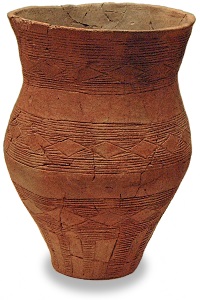
‘Drinking cups’ have a characteristic bell-shaped profile, and so became known as ‘Bell Beakers’ (or just ‘Beakers’). They have a wide distribution in Europe – the earliest, evidently, being from Iberia, where they appeared by 2700 BC. So, for most of the 20th century, the generally held belief was that Britain had been invaded by, the technologically superior, ‘Beaker People’ (or ‘Beaker Folk’).[*] In recent times, however, the notion of an invasion tends to have been put-aside in favour of the idea that the Beaker People were simply the native population, who had adopted ‘Beaker culture’, introduced from the Continent by a limited number of migrants and by trade.[*] But the tables have now turned somewhat. Radiocarbon dates, modelled using Bayesian statistics, indicate that Beaker culture first appeared in Britain about 2450/2400 BC (so the Beaker People are too late to be responsible for constructing the massive sarsen settings at Stonehenge).[*] Genetic research suggests that there was, indeed, substantial migration into Britain from mainland Europe from that time, to the extent that by around 2000 BC, the population of Britain owed less than 10% of its genetic makeup to the Neolithic population.[*] Whilst the Neolithic Brits would have had olive-brown skin, dark hair and brown eyes, the Beaker People introduced genetic variants that produced lighter colouring. (The variant that allows milk to be digested in adulthood did not increase at this time – there is no increase in its frequency, in Britain or mainland Europe, until after 1500 BC.)
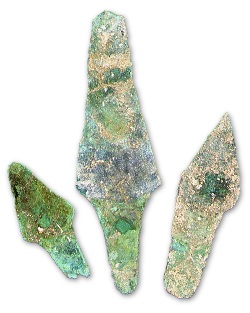


At the beginning of May 2002, the richest Beaker burial known in Britain was uncovered. It was discovered by archaeologists investigating a site at Amesbury, some 3 miles south-east of Stonehenge, in advance of building work. The grave (originally, it probably had a timber lining, and may – there is no surviving evidence – have been covered by a low burial mound) was that of a 35–45 year-old man. Radiocarbon dating places his death around 2350 BC. Typically for the period, he had been laid on his side, in a crouched, as if sleeping, position. Examination of his skeleton revealed that, at some time during his life, he sustained a serious injury to his left knee, leaving him with a painful bone infection and a pronounced limp. He was also suffering from a tooth abscess, and the infection had burst through his jaw. This rather sickly individual, however, was clearly of high status. He was buried with around a hundred objects, which, say Wessex Archaeology who made the discovery, is “ten times the usual number of finds from other graves”. There were the pieces of five Beakers (the usual is just one per grave), three copper knives (one of which, judging by its position, he may well have been wearing), a bone pin (which might have been fastening an item of clothing, such as a leather mantle), a shale ring (identified as a belt-ring), two gold ear or hair ornaments, a ‘cushion stone’ (used in metalworking[*]), four boar-tusks, many flint tools and flakes, a red deer spatula used for working flints. Seventeen ‘barbed and tanged’ flint arrowheads were found in positions which suggested that a quiver full of arrows had been scattered over his lower half. (It seems reasonable to suppose that there would have originally been a bow also, but, like the arrow shafts and any clothing items, it had long since rotted away). He had two sandstone ‘wristguards’ (to protect his wrists from the bow string), one of which he was wearing.[*] These latter items led to the man being nicknamed ‘the Amesbury Archer’. (He was also referred to, somewhat whimsically, as ‘the King of Stonehenge’.) Close by, there was another, smaller and less richly furnished, grave, dating from about the same time as (perhaps slightly later than) the Archer’s. Its occupant was a 20–25 year-old man. He too had been buried with a pair of ear/hair ornaments.[*] Both the Archer and the younger man exhibit the same peculiarity in the bone structure of their feet, demonstrating that the two men were related. Oxygen and strontium isotope analysis of their tooth enamel suggests that, whilst the Archer had grown up in the vicinity of the Alps, the younger man had grown up in southern Britain. Perhaps the younger man was the immigrant Archer’s British born son?

Copper was the metal first used to make tools and weapons. Pure copper is soft and not ideally suited to the purpose, but copper derived from arsenic-rich ores is much stronger. Many of the earliest copper axe-heads in Britain are made of arsenic-rich Irish metal. It was, though, discovered that alloying any copper with tin also produced a strong metal, bronze – and there were excellent tin resources in Cornwall. Metallurgy had been late arriving in Britain – the famous ‘Ötzi the Iceman’, whose well preserved remains were discovered in the Tyrolean Alps in 1991, was carrying a copper axe at the time of his death c.3300 BC, some eight centuries before metalwork appears in Britain – but the switch from copper to bronze came quickly. Around 2200/2150 BC the Bronze Age proper began.
bronze02
It is perhaps not strictly true to say that bronze was invented in Britain. The very earliest combination of tin and copper is found in Anatolia, but Near Eastern bronze contained less tin, in less standardised quantities, than was found in British bronze. Put simply, it was inferior bronze. In Britain, bronze was produced from the outset with an almost standard composition of 8 to 12 per cent tin, ensuring the optimum mix of qualities… Along with Afghanistan, Cornwall is one of only two possible major sources of the tin used in bronze throughout Europe after about 2000 BC. No prehistoric mines have yet been found in Cornwall but this is hardly surprising: the landscape has been eaten away by coastal erosion and turned upside down by the vast scale of the post-medieval tin industry. All prehistoric evidence may have been destroyed.There are, however, several Bronze Age copper mines known in Britain (mainly in Wales), the largest of which is at the Great Orme, Llandudno, where a complex of shafts and galleries descends more than 70 metres. Mining was evidently underway there by 1800 BC, peaked around 1700–1500 BC, and continued to about 600 BC. Some scholars prefer to refer to the first three centuries or so of the British Bronze Age, when Bronze itself is not evident, as the Chalcolithic period or Copper Age.‘Meet the metal makers’
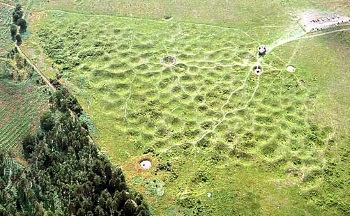
The astonishing skill of early metal-workers is apparent in the decorative gold items they produced. Gold does not tarnish, so these survive (though a little mangled in some cases) looking as lustrous as they did on the day they were manufactured.
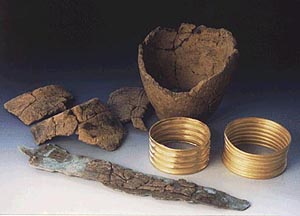
The Lockington Hoard, dated to around 2000 BC, comprises the fragments of two Beakers, a copper dagger (typical of Brittany, and still in the remains of its wooden sheath) and two, embossed gold-sheet, armlets. One of the armlets (originally, they would probably have had a leather backing) has five plain encircling ribs, whilst the three shaped ribs of the other armlet may be simulating a strings of beads. The Hoard was found in a pit within a burial complex, but it wasn't actually with a burial. Intriguingly, the pots were already broken and weathered when they were placed on top of the dagger and armlets.
Beaker-burials evidently fell out of favour in Scotland first, c.2100 BC, and the trend worked south through Britain – Beaker-burials ending in Wessex c.1850 BC.[*] During the period c.2200 BC–c.1700 BC, burials, especially in the North, might be accompanied by ‘food vessels’. These pots would appear to be developed from, indigenous, Neolithic pots, rather than, the Continentally influenced, Beakers. The same is true of the ‘collared urns’, from the period c.2000 BC–c.1500 BC, which were often used to contain cremations.[*]

Bush Barrow.
In Wessex,[*] dating from the first half of the 2nd millennium BC (i.e. 2000–1500 BC), are several very richly furnished barrow burials – the most famous of these being the Golden Barrow and, richest of all, Bush Barrow.[*] At one time these burials were thought to represent a unique ‘Wessex culture’, established by a fresh wave of migrants from Brittany. Today, however, the tendency is to accept that they are simply a development which demonstrates the growing wealth of a local elite.
It’s not, though, just in Wessex that works of exquisite gold craftsmanship dating from this half-millennium have been found.

In 1833, labourers shovelling stones from a mound (known to locals as Bryn-yr-Ellyllon, i.e. Goblins’ Hill) on the outskirts of Mold, in Flintshire, North Wales, uncovered a badly decayed skeleton. The skeleton was wearing the crushed remains of Mold Gold Cape, upon which there was laid a quantity of amber beads. In 1835, most of the cape was sold to the British Museum by the land’s tenant. Only one of the beads ever reached the Museum. It seems likely that the rest were converted into cash by the labourers – along with pieces of the cape. Some of these pieces have, over the years, turned up and been reunited with their fellows. Restoration work, using ‘reinvented technology’ to replace the missing sections (about 15% of the cape), was completed in 2002.[*] Mold Gold Cape was beaten from a single ingot of gold, and then meticulously embossed. Bronze strips, found with the cape, seem to have been used to strengthen the structure, and it appears to have had a textile lining. Despite the reinforcements, it would have been a relatively fragile object, and there is evidence that it had undergone repair. Presumably, it was worn on ceremonial occasions (arm movements would have been seriously restricted), and, clearly, only by someone of slim build – possibly a woman.

In 1837(?), workmen, looking for building stone, found the rotted remains of a human skeleton, in a stone cist set into the edge of “a large mound of earth and stones which had been standing from time immemorial”, at Rillaton, on Bodmin Moor, Cornwall.[*] The grave’s occupant had been buried with a metal “rivet”, “some pieces of ivory”, “a few glass beads”, a bronze dagger, and a gold cup. It seems that the cup was inside an “earthen vase” – the latter being smashed during the excavation. Being Duchy of Cornwall Treasure Trove, the objects were sent to King William IV, and thereafter remained in the royal household. On the death of King George V (who is purported to have used the cup to house his collar studs), in 1936, the cup and dagger (the other items have not survived) were handed over, on permanent loan, to the British Museum. The cup’s body was beaten from one piece of gold, and the handle is attached by rivets (which pass through lozenge-shaped washers). In November 2001, a metal-detectorist, scanning a recently harvested potato-field, discovered a similar gold cup at Ringlemere Farm, near Sandwich, Kent. The cup probably owes its present, somewhat bent, condition to a modern plough. It was found within, what turned out to be, the ploughed-out vestiges of a henge that had, in effect, been converted into a round barrow. Archaeologists looked for a grave, from which the cup might have been dragged by agricultural activity, but failed to find one. The Ringlemere Cup’s method of construction is like the Rillaton Cup, but it is a little larger and the gold is thicker.
At first, life in the Bronze Age appears to have carried on in much the same way as it had in the Neolithic – rather than having a fixed abode, people apparently followed an itinerant way of life. By 1500 BC, however, fundamental changes were underway. People were settling down. Field systems were established. Houses – typically, these are round in plan, hence ‘roundhouses’ – began being grouped together into hamlets.
bronze03
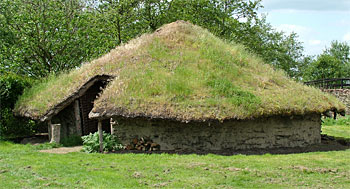 A reconstructed Bronze Age roundhouse at Flag Fen, based on the ground-plan of one found in the vicinity (pictured in 2008). In common with many Bronze Age roundhouses, this one has a circle of internal roof-supports, suggesting that a heavy roof-covering, i.e. turf, was used.
Excavations, in 2015–16, at Must Farm, not 3 miles from Flag Fen, where structural components of Late Bronze Age (i.e. c.1000 BC – c.800 BC) roundhouses, that were built on stilts above a small river, have been very well preserved, indicated that a mixture of turf, clay and thatch was used in the roof-covering. Interestingly, it seems that the house-walls were made of wattle panels, as expected, but no evidence has been found that the panels were covered with daub.
A reconstructed Bronze Age roundhouse at Flag Fen, based on the ground-plan of one found in the vicinity (pictured in 2008). In common with many Bronze Age roundhouses, this one has a circle of internal roof-supports, suggesting that a heavy roof-covering, i.e. turf, was used.
Excavations, in 2015–16, at Must Farm, not 3 miles from Flag Fen, where structural components of Late Bronze Age (i.e. c.1000 BC – c.800 BC) roundhouses, that were built on stilts above a small river, have been very well preserved, indicated that a mixture of turf, clay and thatch was used in the roof-covering. Interestingly, it seems that the house-walls were made of wattle panels, as expected, but no evidence has been found that the panels were covered with daub.

Indeed, perhaps because permanent settlements were providing the sense of place previously supplied by monumental structures, henges and stone circles were abandoned too. The focus of religious activity seems to shift to watery places, such as rivers and bogs, in, or near, which metalwork was deposited, presumably as an offering. The archaeological record indicates that inhumation fell from favour, and cremation became the preferred method of treating the dead. The deposition of cremated remains in round barrows also declined – the trend was towards burying cinerary urns in ‘flat cemeteries’. As in the previous archaeological periods, though, many bodies must have been dealt with in ways that have left little trace – such as committing them, or their cremated remains, to the water.

At Flag Fen, Peterborough, can be seen the preserved remains of a kilometre-long timber causeway, that had bridged a stretch of wetland. In the middle of the causeway was an enormous (more than 2 hectares) timber platform. The whole installation was developed over about four centuries: c.1300 BC – c.900 BC. Whether it was its primary purpose or not, the hundreds of bronze artifacts, many of which appear to have been deliberately broken, that were cast from the causeway, suggest that the installation was used for religious ceremonies.
bronze04
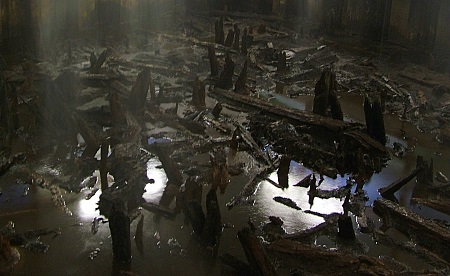 Exposed timbers at Flag Fen are preserved by sprinkling with, cooled, filtered water.
Exposed timbers at Flag Fen are preserved by sprinkling with, cooled, filtered water.
(Incidentally, excavations at Flag Fen, in 1994, unearthed the remains of a Bronze Age, alder and oak, tripartite, wheel – at around 1300 BC, it is the earliest wheel yet found in Britain.[*])
In fact, a surprising number of buried metalwork hoards dating from the closing couple of centuries of the Bronze Age are found by metal-detectorists. For instance, between January 2003 and March 2004, just in Kent, eight were found. Most of these had been scattered by ploughing, but by far the largest – 185 pieces of metalwork – was found in a pit below the ploughsoil, at Crundale.[*] The presence of copper ingot fragments might indicate that the hoard was a stash of scrap metal, collected by a metal-worker, destined for recycling. This is the traditional interpretation of such finds, and they are sometimes called “founders’ hoards”. However, in this case, some objects seem to have been deliberately rendered unfit for purpose. This phenomenon has been found with other hoards, which raises the possibility that, rather than being simply forgotten heaps of scrap metal, they too are ritual deposits.

bronze05
Late Bronze Age swords are the first weapons uniquely devised for warfare… [they] are designed for slashing and only make sense when used for fighting in groups.
These swords have leaf-shaped blades, balance well forward of the wrist and some even have blunt points. Unlike thin-bladed rapiers, these swords have hilts cast as an intrinsic part of the weapon and can therefore be used for slashing without coming apart. Swords are more likely to disable than kill, but few weapons are as useful in a mêlée. A rapier- or spear-user requires accuracy and time, and leaves himself open to attack from the side; while the user of an axe or club becomes exhausted in prolonged battle. Late Bronze Age swords must have been invented by societies already used to war, and aware of the limitations of other weapons.
I have examined several hundred Late Bronze Age swords and would maintain that the majority bear signs of edge damage consistent with blade-on-blade impact. They tend to have numerous nicks and small wave-like distortions of the edges. The nicks are unlike the signs of attempted complete destruction often found on blades in ritual deposits, and the rippled blades cannot have been caused by faulty casting.
It would be surprising if sword users were not the élite of warriors. Bronze swords are far from easy to make – the clay moulds themselves require careful preparation and only expert casting can prevent the creation of hidden flaws. Hammering and heating the edges repeatedly, without cracking the metal, is particularly difficult in tin bronze. Nonetheless the vast majority of blades have micro-structures which show this was done with consistent results.‘The first weapons devised only for war’
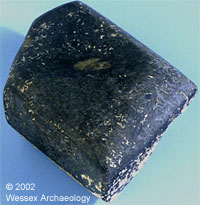 ‘Cushion stones’ were named by J.J. Butler and J.D. van der Waals, because their shape resembles a sofa cushion:
‘Cushion stones’ were named by J.J. Butler and J.D. van der Waals, because their shape resembles a sofa cushion:
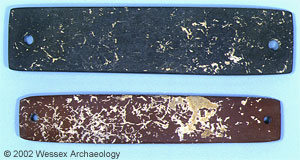 The Archer was wearing the black wristguard. The red one was placed adjacent to his knees – along with one of the copper knives, the shale ring and the pair of gold ornaments. It seems probable that there would also have been some items of clothing originally. A simple leather cuff would have been perfectly adequate to use as a wristguard, so it seems likely that stone ones were status symbols.
The Archer was wearing the black wristguard. The red one was placed adjacent to his knees – along with one of the copper knives, the shale ring and the pair of gold ornaments. It seems probable that there would also have been some items of clothing originally. A simple leather cuff would have been perfectly adequate to use as a wristguard, so it seems likely that stone ones were status symbols.
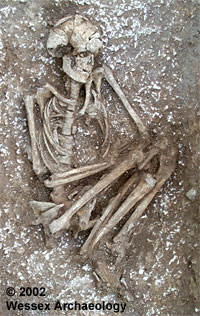 Above: the Archer’s companion. His gold ear/hair ornaments were found inside his jaw.
Above: the Archer’s companion. His gold ear/hair ornaments were found inside his jaw.
 The Lockington Hoard was discovered in 1994, by archaeologists excavating an Early Bronze Age barrow cemetery, ahead of road construction, at Lockington in Leicestershire. Radiocarbon assays of two samples taken from the organic remains attached to the dagger produced the date-ranges 2580–2200 BC and 2190–1880 BC. The latter range is most compatible on typological grounds.
The Lockington Hoard was discovered in 1994, by archaeologists excavating an Early Bronze Age barrow cemetery, ahead of road construction, at Lockington in Leicestershire. Radiocarbon assays of two samples taken from the organic remains attached to the dagger produced the date-ranges 2580–2200 BC and 2190–1880 BC. The latter range is most compatible on typological grounds.
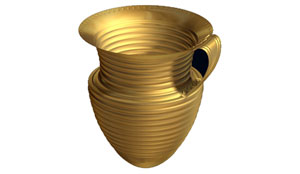 It is estimated that the Ringlemere Cup was originally 123mm high with a rim diameter of 109mm. It weighs 183.7g. The Rillaton Cup has a rim diameter of 85mm (give or take), and it is estimated that it was originally 95mm high (its base has evidently been flattened since its discovery, so that it will stand). It weighs 76.6g.
Images courtesy of the
It is estimated that the Ringlemere Cup was originally 123mm high with a rim diameter of 109mm. It weighs 183.7g. The Rillaton Cup has a rim diameter of 85mm (give or take), and it is estimated that it was originally 95mm high (its base has evidently been flattened since its discovery, so that it will stand). It weighs 76.6g.
Images courtesy of the 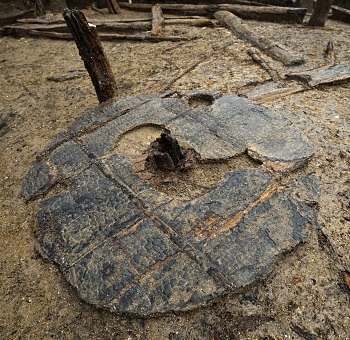
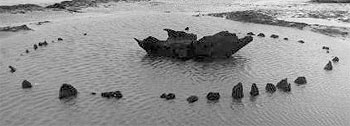 In August 1998, Seahenge (as it was soon christened), a circle of 55 oak posts with an upturned oak-stump at its centre, was exposed on the beach at Holme-next-the-Sea, Norfolk.
In August 1998, Seahenge (as it was soon christened), a circle of 55 oak posts with an upturned oak-stump at its centre, was exposed on the beach at Holme-next-the-Sea, Norfolk.